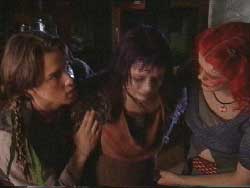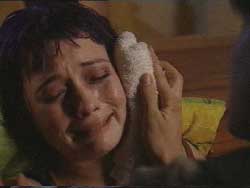This week we take a look at the process of giving birth in the real world and in the world of The Tribe.

BEFORE THE BIRTH
Pregnant women are closely monitored by their midwife or doctor to make sure that all is going well and that baby and mother are healthy. Ultrasounds are carried out to chart the development of the growing foetus and many blood and urine tests are done to make sure that there is nothing wrong with the mother. The doctor or midwife gets a good idea as to when the baby should arrive and the mother can plan on where she wants to go for the labour, hospital or a home birth. But if a premature labour starts or there are other complications (such as bleeding, high blood pressure or diabetes) the mother is whisked straight in to hospital.

GIVING BIRTH
Most women are lucky enough to have normal labours that start with cramps in the tummy and get progressively worse. Some women have to go in to hospital for a Caesarean section because they are not able to give birth naturally. And some women have to get their labour induced medically because of high blood pressure or other health problems. Labour goes something like this: –
FIRST STAGE
This begins with period type pains at the top of the tummy and in the small of the back. The pains are quite irregular but get stronger and come closer together. Sometimes the bag of fluid that surrounds and protects the baby bursts and once this happens the woman should make her way in to hospital or get her midwife to come to the house (if it is to be a home delivery) because an infection can now reach the baby.
When the pains are more regular and come close together (every 5 minutes or so) the woman needs to go to hospital or get ready for her home birth. The midwife or doctor will do an internal examination to check how far the cervix is dilated. When it is 10cms dilated the baby is ready to start its journey down from the uterus. Dilation can happen quickly but is more usually a longer process, especially in a first labour. It can take several hours. Some women find that moving around in this stage helps the process along a bit. Others need a bit of pain relief. Entonox, Pethidine or an Epidural is administered at this stage if pain relief is required.
TRANSITION
 When the cervix is reaching full dilation and the body is getting all the messages that it is about to deliver the baby, there is a stage that the woman goes through called transition. This can affect different women in different ways but a lot of women feel quite upset and grumpy and unable to cope. They get the shakes and can feel nauseous and vomit. Thankfully this does not last too long!
When the cervix is reaching full dilation and the body is getting all the messages that it is about to deliver the baby, there is a stage that the woman goes through called transition. This can affect different women in different ways but a lot of women feel quite upset and grumpy and unable to cope. They get the shakes and can feel nauseous and vomit. Thankfully this does not last too long!
SECOND STAGE
This stage starts when the cervix is fully dilated and the contractions are coming strongly and rapidly, every minute or so. The woman can start pushing her baby down the birth canal and this can take anywhere from twenty minutes to three hours. The midwife or doctor tells the woman how and when to push. The urge to push is a natural one but some women need to be talked through the process. If the birth canal has some bone in the way, the baby will come out in the breech position or if the baby appears to be distressed, there is the need for an emergency Caesarean section to get the baby out immediately.
THIRD STAGE
 The baby has been delivered but the uterus continues to contract until the placenta has been delivered.
The baby has been delivered but the uterus continues to contract until the placenta has been delivered.
The placenta is then checked over to make sure that none of it has been left in the uterus because it would cause a bad infection. Before the introduction of modern medicines, this infection was often fatal in the past and was the cause of death for many mothers after childbirth.
TRIBAL PREGNANCY AND CHILDBIRTH
 The Tribal girls did not have the luxury of medical help during their pregnancies and had to rely upon their natural instincts to tell them what to do. They would have had to listen very carefully to their bodies and thankfully no major health scares came out of these pregnancies. Salene coped after her miscarriage physically and emotionally. Both Trudy and Amber’s labours started at the right time in the right fashion. Trudy got through her postnatal depression with the help and support of her friends and it was lucky that Dal was able to find some antibiotics to help her recover from the puerperal (or childbed) fever. We will have to wait and see how childbirth goes for poor Amber, last seen bleeding in the barn.
The Tribal girls did not have the luxury of medical help during their pregnancies and had to rely upon their natural instincts to tell them what to do. They would have had to listen very carefully to their bodies and thankfully no major health scares came out of these pregnancies. Salene coped after her miscarriage physically and emotionally. Both Trudy and Amber’s labours started at the right time in the right fashion. Trudy got through her postnatal depression with the help and support of her friends and it was lucky that Dal was able to find some antibiotics to help her recover from the puerperal (or childbed) fever. We will have to wait and see how childbirth goes for poor Amber, last seen bleeding in the barn.
Of course, the Tribal girls have to give birth the natural way, no painkillers or water births. No doctors or hospitals. They just had to get on with things and hope for the best.
GLOSSARY
Breech position… this is when the baby comes out feet or legs first rather than head first.
Caesarean Section… the operation where the abdomen is cut in to and the baby lifted out of the uterus.
Cervix… the birth canal.
Dilation… the widening of the cervix (widens to 10cms.)
Entonox… a gas and air painkiller that is breathed in.
Epidural… a painkiller that is injected in to a space in the spine numbing the tummy, back and legs to a degree.
Foetus… the developing baby.
Induced … the process of kick-starting the labour if it has not started naturally.
Labour… the process of childbirth, starting with tummy pains and ending in the birth of the baby. Usually starts at 40 weeks.
Pethidine… a painkilling injection.
Placenta… the protective sac that surrounds the growing foetus.
Premature labour… when childbirth starts well before the due time.
Ultrasound… a scan of the growing foetus inside the uterus.
Uterus… the womb, the place where the baby grows.


